A Driving Waveform with a Narrow Falling and High-Voltage Reset Structure for Improving the Stability of Electrowetting Displays
Abstract
1. Introduction
2. Principle of EWDs
2.1. Principle of EWDs
2.2. Oil Film Splitting
3. Experimental Results and Discussion
3.1. Experimental Platform
3.2. Proposed Driving Waveforms
3.3. Testing of the Shrinkage Stage
3.4. Testing of the Stabilizing Stage
3.5. Performance of the Proposed Waveform
4. Conclusions
Author Contributions
Funding
Data Availability Statement
Conflicts of Interest
References
- Jones, T. An Electromechanical interpretation of electrowetting. J. Micromechan. Microeng. 2005, 15, 1184–1187. [Google Scholar] [CrossRef]
- Beni, G.; Hackwood, S. Electrowetting displays. Appl. Phys. Lett. 1981, 38, 207–209. [Google Scholar] [CrossRef]
- Sethi, S.; Kadian, S.; Gogoi, R.; Manik, G. Layer-by-layer fabrication of self-cleaning superhydrophobic surface made from Carboxymethylcellulose and ZnO quantum dots: A combined experimental and computational study. Surf. Interfaces 2023, 37, 102752. [Google Scholar] [CrossRef]
- Sethi, S.; Singh, M.; Manik, G. A multi-scale modeling and simulation study to investigate the effect of roughness of a surface on its self-cleaning performance. Mol. Syst. Des. Eng. 2020, 5, 1277–1289. [Google Scholar] [CrossRef]
- Zhang, S.; Huang, J.; Chen, Z.; Lai, Y. Bioinspired special wettability surfaces: From fundamental research to water harvesting applications. Small 2017, 13, 1602992. [Google Scholar] [CrossRef]
- Hayes, R.; Feenstra, B. Video-speed electronic paper based on electrowetting. Nature 2003, 425, 383–385. [Google Scholar] [CrossRef]
- Kao, W.; Tsai, J. Driving method of three-particle electrophoretic displays. IEEE Trans. Electron Devices 2018, 65, 1023–1028. [Google Scholar] [CrossRef]
- Wang, L.; Yi, Z.; Jin, M.; Shui, L.; Zhou, G. Improvement of video playback performance of electrophoretic displays by optimized waveforms with shortened refresh time. Displays 2017, 49, 95–100. [Google Scholar] [CrossRef]
- He, W.; Yi, Z.; Shen, S.; Huang, Z.; Liu, L.; Zhang, T.; Li, W.; Wang, L.; Shui, L.; Zhang, C.; et al. Driving waveform design of electrophoretic display based on optimized particle activation for a rapid response speed. Micromachines 2020, 11, 498. [Google Scholar] [CrossRef]
- Yi, Z.; Bai, P.; Wang, L.; Zhang, X.; Zhou, G. An electrophoretic display driving waveform based on improvement of activation pattern. J. Cent. South Univ. 2014, 21, 3133–3137. [Google Scholar] [CrossRef]
- Shen, S.; Gong, Y.; Jin, M.; Yan, Z.; Xu, C.; Yi, Z.; Zhou, G.; Shui, L. Improving electrophoretic particle motion control in electrophoretic displays by eliminating the fringing effect via driving waveform design. Micromachines 2018, 9, 143. [Google Scholar] [CrossRef]
- Gao, J.; Mendel, N.; Dey, R.; Baratian, D.; Mugele, F. Contact angle hysteresis and oil film lubrication in electrowetting with two immiscible liquids. Appl. Phys. Lett. 2018, 112, 203703. [Google Scholar] [CrossRef]
- Roques-Carmes, T.; Hayes, R.; Schlangen, L. A physical model describing the electro-optic behavior of switchable optical elements based on electrowetting. J. Appl. Phys. 2004, 96, 6267–6271. [Google Scholar] [CrossRef]
- Wu, H.; Dey, R.; Siretanu, I.; van den Ende, D.; Shui, L.L.; Zhou, G.F.; Mugele, F. Electrically controlled localized charge trapping at amorphous fluoropolymer-electrolyte interfaces. Small 2020, 16, 1905726. [Google Scholar] [CrossRef]
- Li, W.; Wang, L.; Heinzen, A. A multi waveform adaptive driving scheme for reducing hysteresis effect of electrowetting display. Front. Phys. 2020, 8, 618811. [Google Scholar] [CrossRef]
- Long, Z.; Yi, Z.; Zhang, H.; Liu, L.; Shui, L. Toward suppressing charge trapping based on a combined driving waveform with an AC reset signal for electro-fluidic displays. Membranes 2022, 12, 1072. [Google Scholar] [CrossRef]
- Heikemfed, J.; Zhou, K.; Kreit, E.; Raj, B.; Yang, S.; Sun, B.; Milarcik, A.; Clapp, L.; Schwartz, R. Electrofluidic displays using Young–Laplace transposition of brilliant pigment dispersions. Nat. Photon. 2009, 3, 292–296. [Google Scholar] [CrossRef]
- Qian, M.; Lin, S.; Zeng, S.; Lin, Z.; Guo, T.; Tang, B. Real-time dynamic driving system implementation of electrowetting display. Opto–Electron. Eng. 2019, 46, 87–95. [Google Scholar]
- Li, W.; Wang, L.; Zhang, T.; Lai, S.; Liu, L.; He, W.; Zhou, G.; Yi, Z. Driving waveform design with rising gradient and sawtooth wave of electrowetting displays for ultra-low power consumption. Micromachines 2020, 11, 145. [Google Scholar] [CrossRef]
- Yi, Z.; Liu, L.; Wang, L.; Li, W.; Shui, L.; Zhou, G. A driving system for fast and precise grayscale response based on amplitude-frequency mixed modulation in TFT electrowetting displays. Micromachines 2019, 10, 732. [Google Scholar] [CrossRef]
- Yi, Z.; Zhang, H.; Zeng, W.; Feng, H.; Long, Z.; Liu, L.; Hu, Y.; Zhou, X.; Zhang, C. Review of driving waveform for electrowetting displays. Front. Phys. 2021, 9, 728804. [Google Scholar] [CrossRef]
- Xu, Z. An algorithm for selecting the most accurate protocol for contact angle measurement by drop shape analysis. Rev. Sci. Instrum. 2015, 85, 125107. [Google Scholar] [CrossRef] [PubMed]
- Li, F.; Mugele, F. How to make sticky surfaces slippery: Contact angle hysteresis in electrowetting with alternating voltage. Appl. Phys. Lett. 2008, 92, 244108. [Google Scholar] [CrossRef]
- Luo, Z.; Fan, J.; Xu, J.; Zhou, G.; Liu, S. A novel driving scheme for oil-splitting suppression in electrowetting display. Opt. Rev. 2020, 27, 339–345. [Google Scholar] [CrossRef]
- Li, S.; Xu, Y.; Zhan, Z.; Du, P.; Liu, L.; Li, Z.; Wang, H.; Bai, P. Dynamic adaptive display system for electrowetting displays based on alternating current and direct current. Micromachines 2022, 13, 1791. [Google Scholar] [CrossRef]
- Xu, Y.; Li, S.; Wang, Z.; Zhang, H.; Li, Z.; Xiao, B.; Guo, W.; Liu, L.; Bai, P. Design of multi-DC overdriving waveform of electrowetting displays for gray scale consistency. Micromachines 2023, 14, 684. [Google Scholar] [CrossRef]
- Lai, S.; Zhong, Q.; Sun, H. Driving waveform optimization by simulation and numerical analysis for suppressing oil-splitting in electrowetting displays. Front. Phys. 2021, 9, 720515. [Google Scholar] [CrossRef]
- He, T.; Jin, M.; Eijkel, J.C.T.; Zhou, G.; Shui, L. Two-phase microfluidics in electrowetting displays and its effect on optical performance. Biomicrofluidics 2016, 10, 011908. [Google Scholar] [CrossRef]
- Lu, Y.; Tang, B.; Yang, G.; Guo, Y.; Liu, L.; Henzen, A. Progress in advanced properties of electrowetting displays. Micromachines 2021, 12, 206. [Google Scholar] [CrossRef]
- Yi, Z.; Huang, Z.; Lai, S.; He, W.; Wang, L.; Chi, F.; Zhang, C.; Shui, L.; Zhou, G. Driving waveform design of electrowetting displays based on an exponential function for a stable grayscale and a short driving time. Micromachines 2020, 11, 313. [Google Scholar] [CrossRef]
- Massard, R.; Mans, J.; Adityaputra, A.; Leguijt, R.; Staats, C.; Giraldo, A. Colored oil electrowetting displays. J. Inf. Disp. 2013, 14, 1–6. [Google Scholar] [CrossRef]
- Berge, B. Electrocapillarity and wetting or insulator films by water. C. R. Acad. Sci. Ser. II 1993, 317, 157–163. [Google Scholar]
- Verheijen, H.; Prins, M. Reversible electrowetting and trapping of charge: Model and experiments. Langmuir 1999, 15, 6616–6620. [Google Scholar] [CrossRef]
- Zhao, Q.; Tang, B.; Dong, B.; Li, H.; Zhou, R.; Guo, Y.; Dou, Y.; Deng, Y.; Groenewold, J.; Henzen, A.; et al. Electrowetting on dielectric: Experimental and model study of oil conductivity on rupture voltage. J. Phys. D-Appl. Phys. 2018, 51, 195102. [Google Scholar] [CrossRef]
- Long, Z.; Yi, Z.; Zhang, H.; Lv, J.; Liu, L.; Chi, F.; Shui, L.; Zhang, C. Toward suppressing oil backflow based on a combined driving waveform for electrowetting displays. Micromachines 2022, 13, 948. [Google Scholar] [CrossRef]
- Tian, L.; Bai, P. A combined pulse driving waveform with rising gradient for improving the aperture ratio of electrowetting displays. Front. Phys. 2021, 9, 709151. [Google Scholar] [CrossRef]


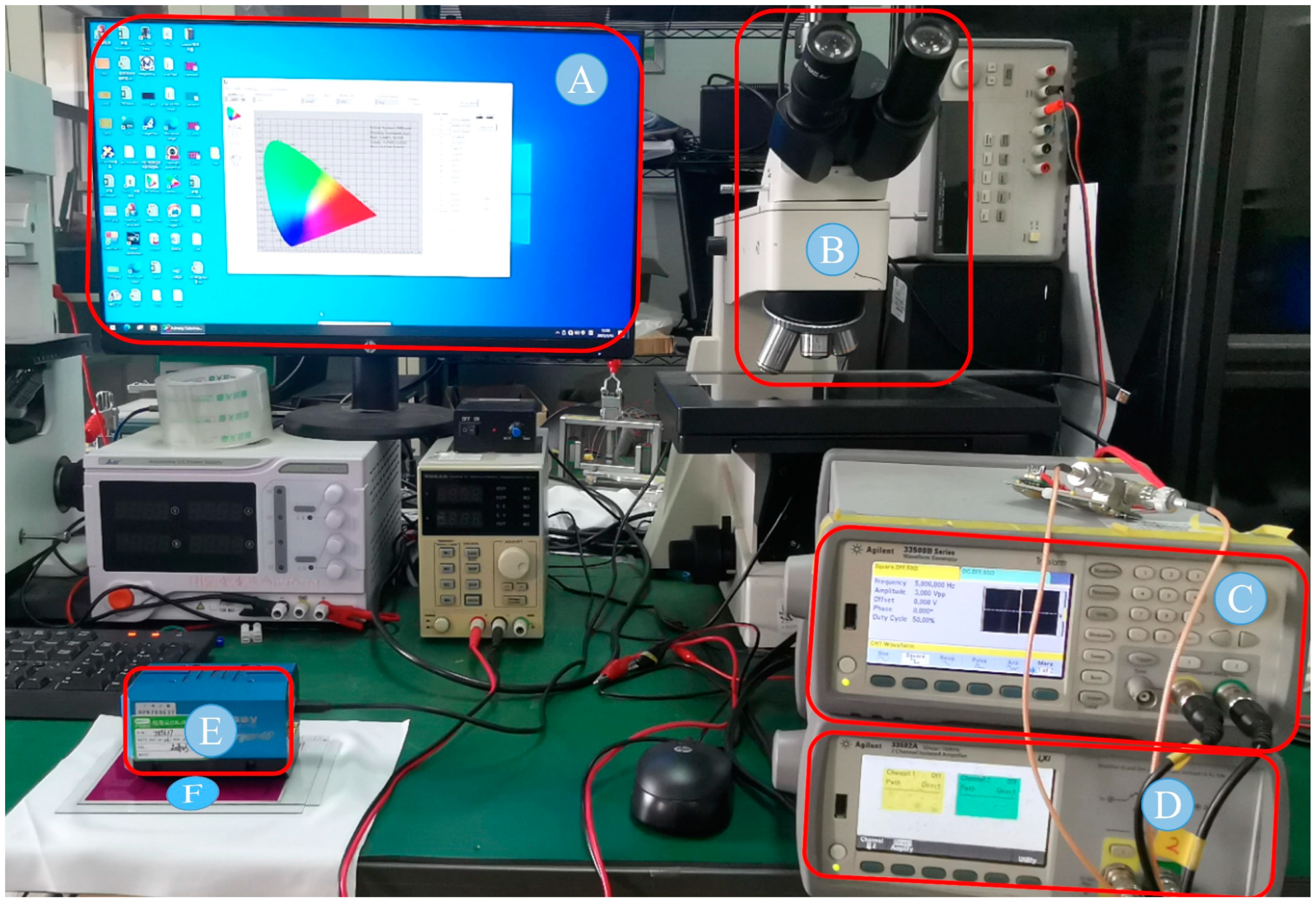
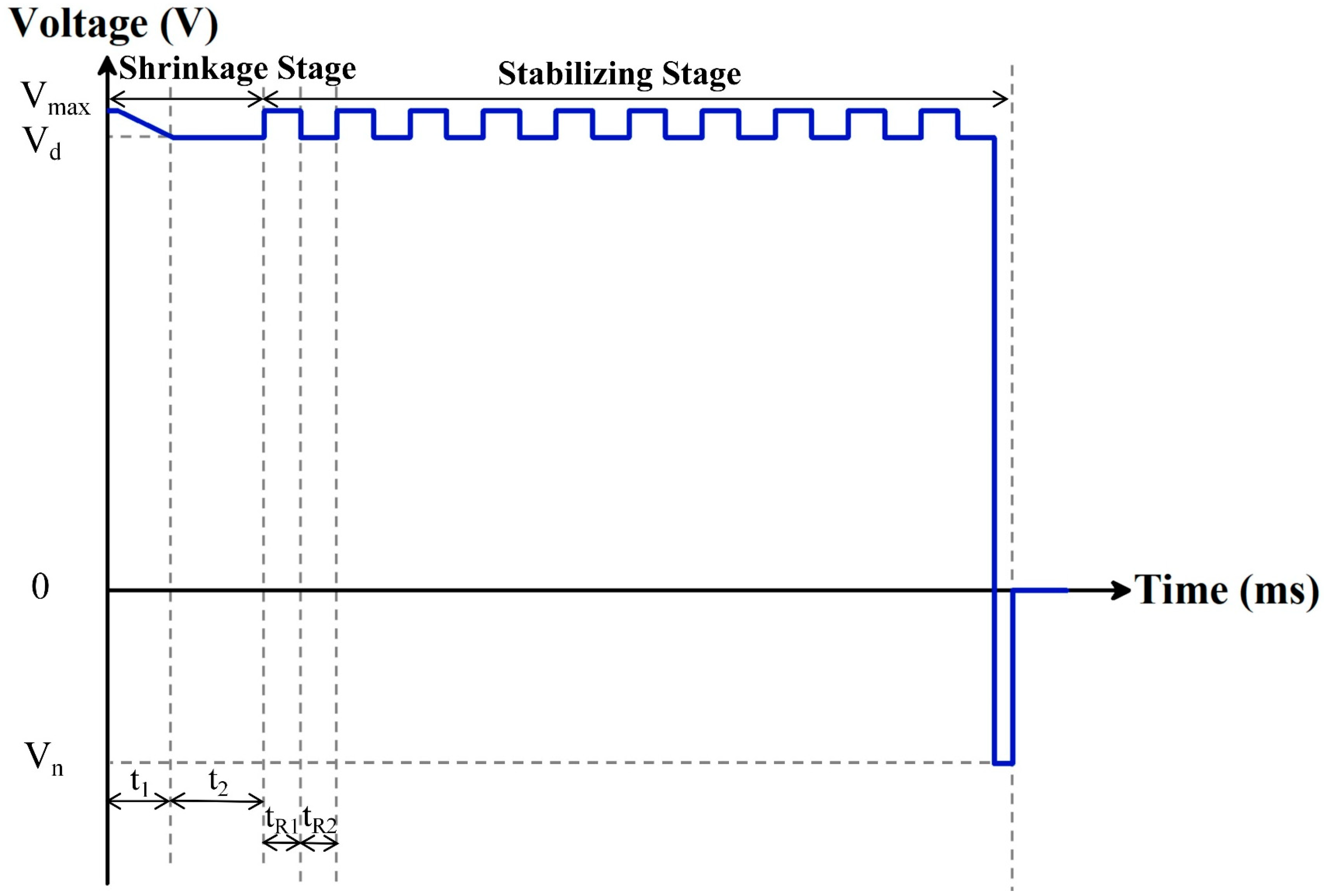


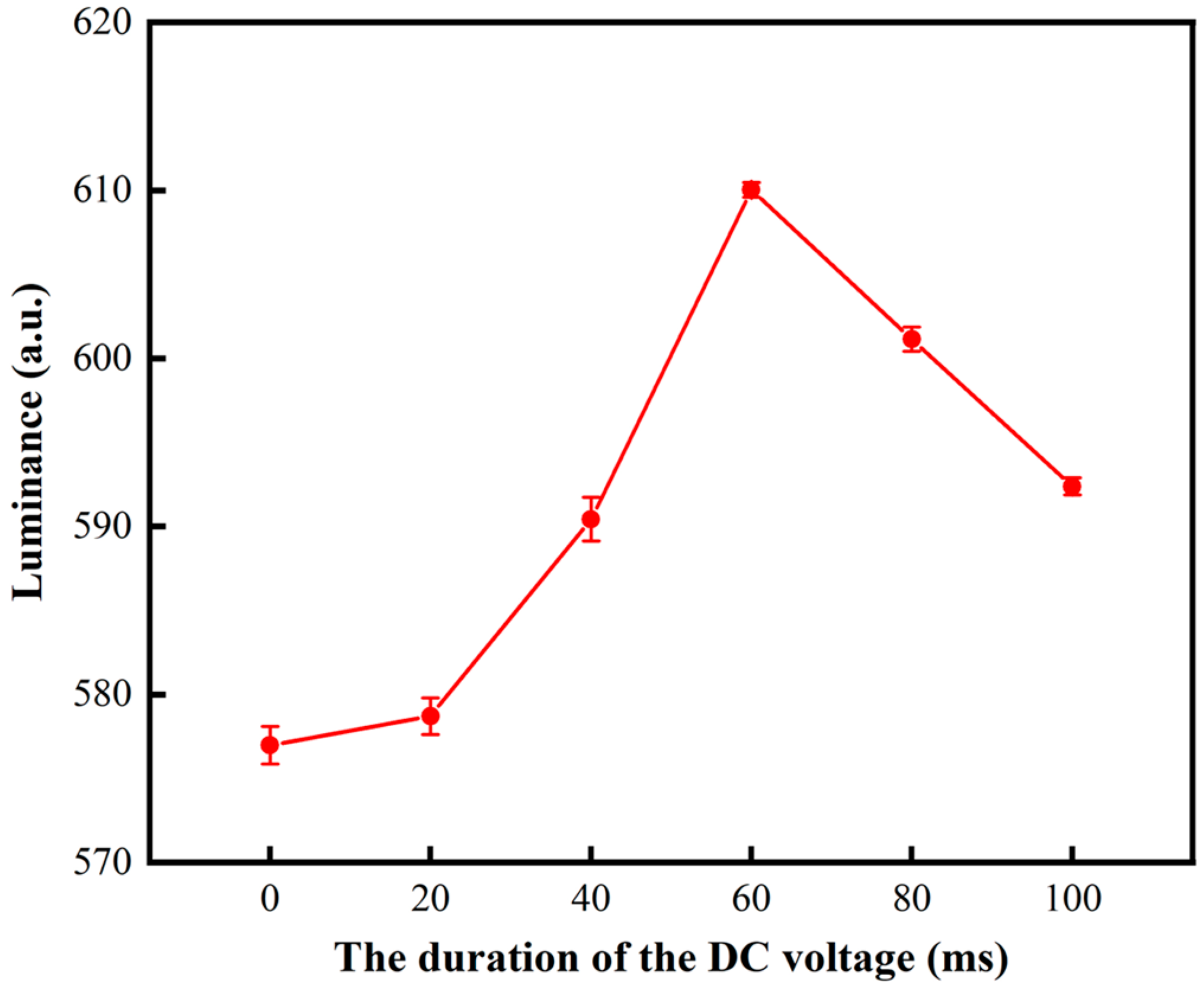
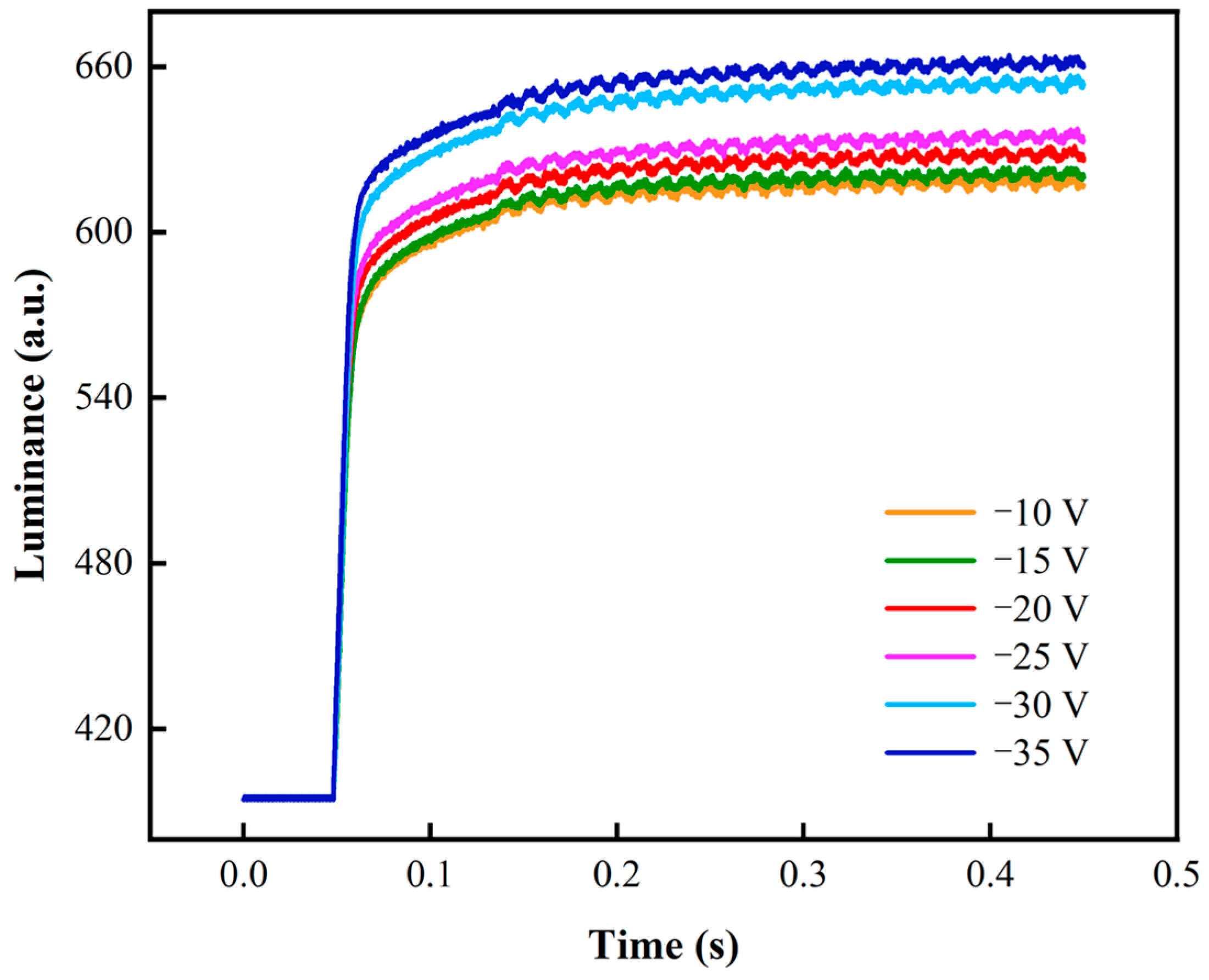
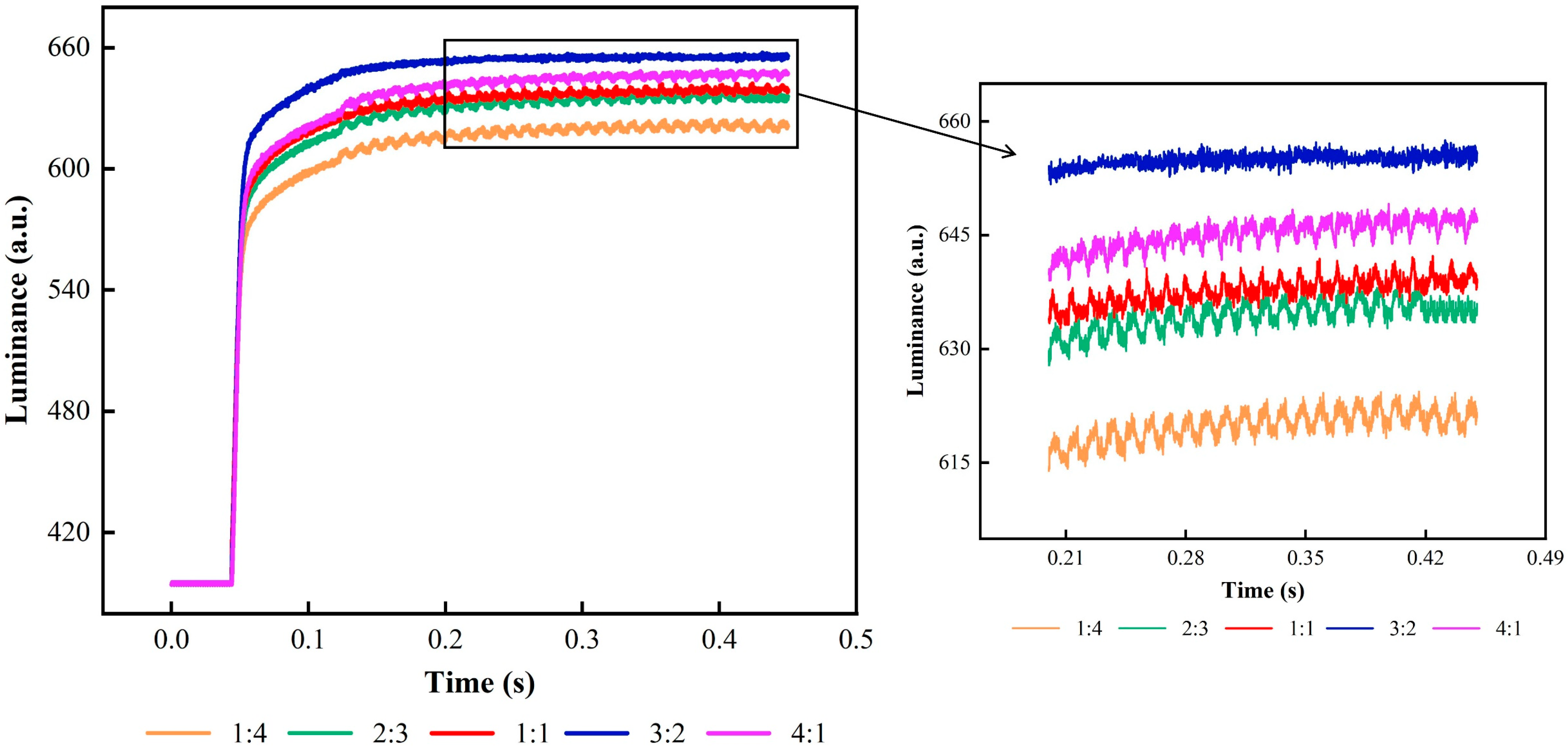
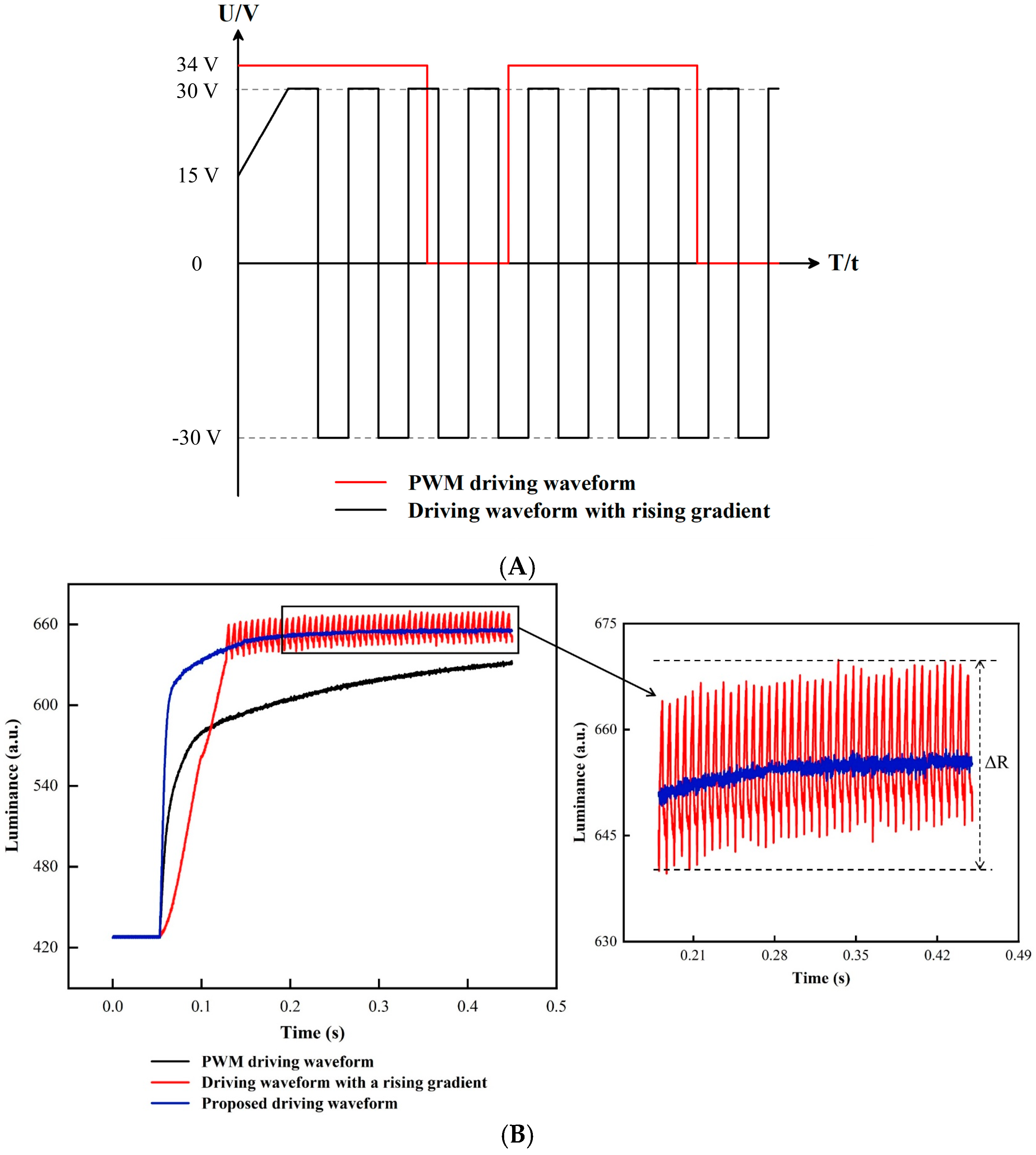
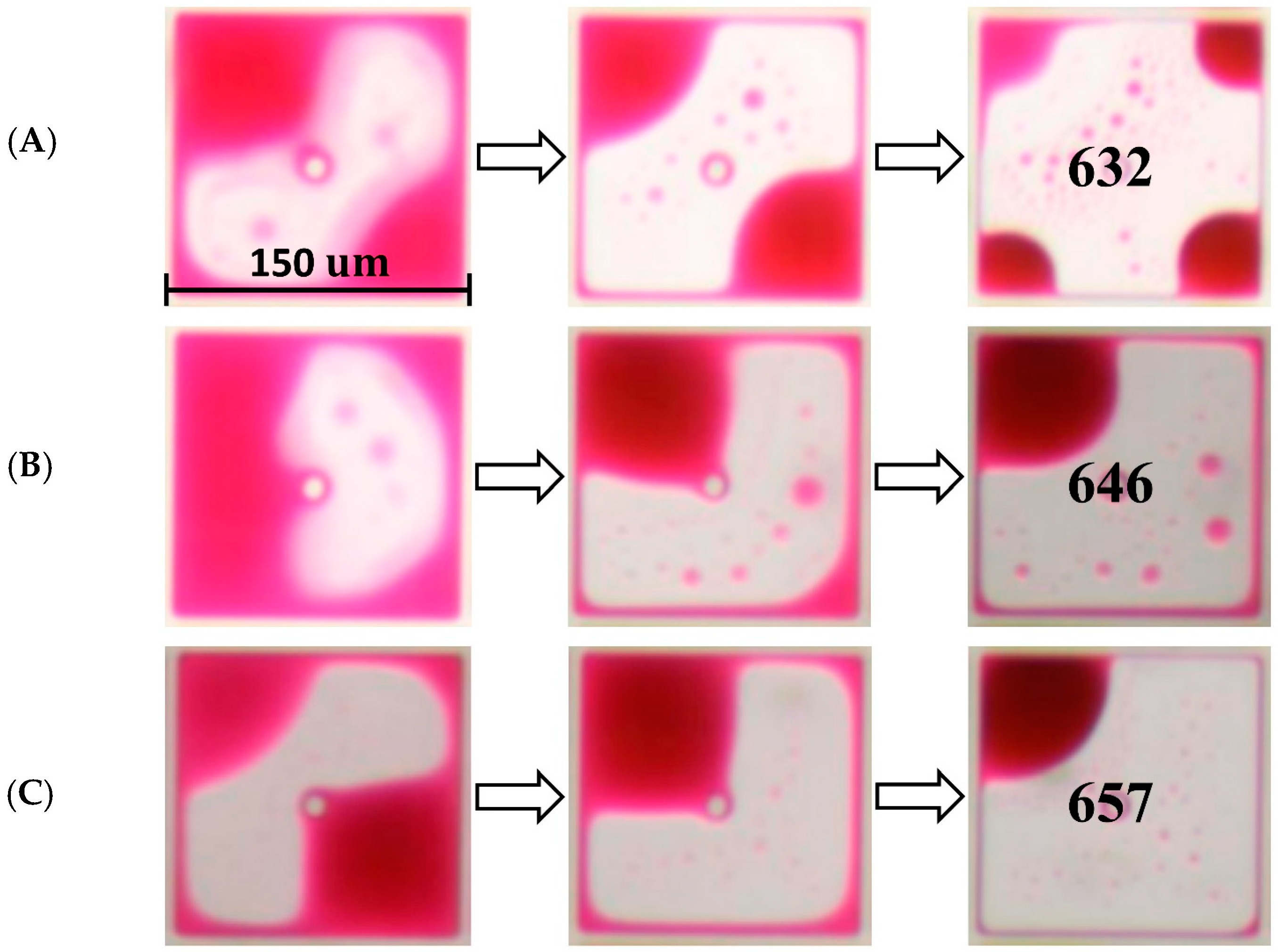
| Name | Model | Brand | Region | Country |
|---|---|---|---|---|
| Function generator | AFG30222C | Tektronix | Beaverton | USA |
| Voltage amplifier | ATA-2022H | Agitek | Xian | China |
| Computer | H430 | Lenovo | Beijing | China |
| Colorimeter | Arges-45 | Admesy | Ittervoort | Netherlands |
| Electron microscope | SZ680 | Cnoptec | Chongqing | China |
| Panel Size (cm2) | Pixel Size (μm2) | Resolution | Hydrophobic Insulating Layer (μm) | Pixel Wall Height (μm) | Color |
|---|---|---|---|---|---|
| 10 × 10 | 150 × 150 | 320 × 240 | 0.8 | 18 | Magenta |
| Negative Voltage | −10 V | −15 V | −20 V | −25 V | −30 V | −35 V |
|---|---|---|---|---|---|---|
| Average (a.u.) | 617 | 619 | 626 | 633 | 650 | 656 |
| Standard deviation | 2.29 | 2.19 | 2.08 | 1.99 | 1.87 | 1.79 |
| Duty Ratio | 1:4 | 2:3 | 1:1 | 3:2 | 4:1 |
|---|---|---|---|---|---|
| Average (a.u.) | 620 | 634 | 638 | 658 | 645 |
| Amplitude (a.u.) | 10.44 | 10.98 | 9.57 | 5.79 | 10.12 |
| Standard deviation | 1.93 | 1.89 | 1.78 | 0.81 | 1.45 |
| Driving Waveform | PWM Driving Waveform | Driving Waveform with a Rising Gradient | Proposed Driving Waveform |
|---|---|---|---|
| Average (a.u.) | 614 | 655 | 654 |
| Response time (ms) | 63 | 127 | 97 |
| Standard deviation | 8.69 | 6.23 | 0.68 |
Disclaimer/Publisher’s Note: The statements, opinions and data contained in all publications are solely those of the individual author(s) and contributor(s) and not of MDPI and/or the editor(s). MDPI and/or the editor(s) disclaim responsibility for any injury to people or property resulting from any ideas, methods, instructions or products referred to in the content. |
© 2023 by the authors. Licensee MDPI, Basel, Switzerland. This article is an open access article distributed under the terms and conditions of the Creative Commons Attribution (CC BY) license (https://creativecommons.org/licenses/by/4.0/).
Share and Cite
Long, Z.; Yi, Z.; Wang, J.; Liu, L.; Chi, F.; Shui, L.; Tan, D.; Wang, H. A Driving Waveform with a Narrow Falling and High-Voltage Reset Structure for Improving the Stability of Electrowetting Displays. Coatings 2023, 13, 935. https://doi.org/10.3390/coatings13050935
Long Z, Yi Z, Wang J, Liu L, Chi F, Shui L, Tan D, Wang H. A Driving Waveform with a Narrow Falling and High-Voltage Reset Structure for Improving the Stability of Electrowetting Displays. Coatings. 2023; 13(5):935. https://doi.org/10.3390/coatings13050935
Chicago/Turabian StyleLong, Zhengxing, Zichuan Yi, Jiashuai Wang, Liming Liu, Feng Chi, Lingling Shui, Ding Tan, and Huan Wang. 2023. "A Driving Waveform with a Narrow Falling and High-Voltage Reset Structure for Improving the Stability of Electrowetting Displays" Coatings 13, no. 5: 935. https://doi.org/10.3390/coatings13050935
APA StyleLong, Z., Yi, Z., Wang, J., Liu, L., Chi, F., Shui, L., Tan, D., & Wang, H. (2023). A Driving Waveform with a Narrow Falling and High-Voltage Reset Structure for Improving the Stability of Electrowetting Displays. Coatings, 13(5), 935. https://doi.org/10.3390/coatings13050935







